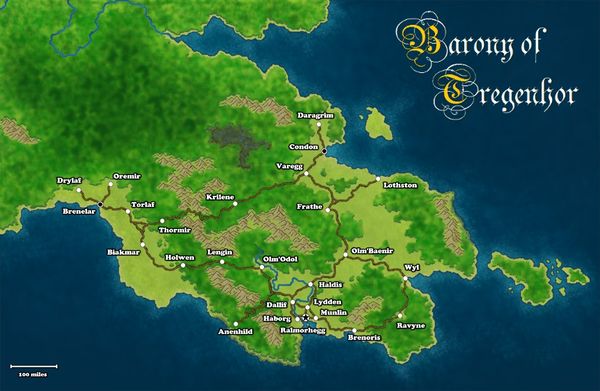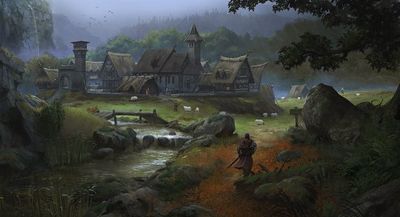Barony of Tregenhor
| WARNING: the information contained on this page has details specific to characters having the Area Knowledge (Tregenhor) skill. |
Main: Kaliteth | Lands of Kaliteth | Kingdom of Turthann
The Barony of Tregenhor (tray-gen-hore), a territory of the Kingdom of Turthann, is the sole territory of humankind found on the continent of Kaliteth. Located in the southeastern most corner of Kaliteth, the closest point on the continent to the Turthann on Ibiend. The town of Ralmorhegg, with a population of just over 3,000, serves as the capital of the barony. The approximate human population of Tregenhor is around 6,000, make this the smallest barony of the kingdom.
History
Discovery of Kaliteth
On the 8th of Hiadhul, 711, during an exploration voyage to find the rumored Kingdom of Eliron of Thaledon to the far north, a Turthannian merchant ship unexpectedly discovered a new land. Excited by this discovery, the captain cancelled his planned voyage and instead spent the next four months charting and navigating around the continent, as wells as make several short forays ashore. Upon their return, the told the king of this new land, presented the charts and told their tales of what they had seen on the shores. After naming this new land “Kaliteth”, the king commissioned additional exploration missions to discover more about this and to establish the initial outposts needed to lay claim to these lands.
On the 21st of Naffiodhiol, 711, a company of soldiers, explorers and scholars arrived at the southeastern most point of Kaliteth, the closest distance to Turthann, where they established an encampment to serve as their base of operations for the planned surveys of Kaliteth. What they soon discovered was that Kaliteth was a wild land, uninhabited by mankind, but rich in resources and wildlife. They further discovered that land was teaming with mythical creature and monsters, few of which had ever been encountered anywhere else known to mankind. Many explorers never returned from surveys deep into the interior.
Founding of the Barony
Over time, the initial exploration encampment grew to a sizable outpost. Daring and adventurous individuals were draw to Kaliteth, with hopes of heroic deeds, challenging hunts and carving a fortune out of the wilderness. A particularly farsighted and ambitious knight, Daman of Mingralt, recognizing the value of this new land, went before the king with a proposal to establish a new barony on Kaliteth, to expand Turthann.
On the 12th of Tharullo, 717, the king of Turthann officially declared the formation of the new barony, the Barony of Tregenhor, and granted the title of baron to the knight, Daman of Mingralt. A little more than five weeks later, on the 20th of Munetla, 717, after moving his family to Kaliteth, Baron Tregenhor, took command of the outpost and officially established the location as the village of Ralmorhegg.
Over the last 32 years, Ralmorhegg has grown in size to a town of over 3,000 and there are a currently 23 hamlets and 2 villages within the barony, bringing the total population to just under 6,000 in total.
Straihlbalt Invasion
The king of Straihlbalt has been aggressively expanding his territory over the last eighteen years, heavily funding exploration, colonization and an ever growing military force to annex or eliminate any native settlements encountered. Although some of this expansion has pushed to the west, most of his efforts have been focused to the south and east, across the Bildati Islands and to the shores of Ibiend. After several conflicts over the last few years as Straihlbalt forces sacked remote Turthann settlements, followed by several failed attempts to negotiate treaties, the king of Turthann officially declared war with Staihlbalt, on 18th of Tiashann, 748.
On the 4th of Lanra, 748, a Staihlbalt fleet of five ships, and a military force of nearly 300, landed on the western coast of the Barony of Tregenhor, approximately 100 miles to the south and west of the hamlets of Biakmar and Holwen. There they began efforts to establish a basic defensive fort and scouting the interior of the barony.
1st Battle of Thurdetch - After learning of Staihlbalt invasion force (13th of Lanra), Baron Daman Tregenhor sent scouts to evaluate the Staihlbalt army, while he issued commands for the knights to marshal militia in preparation for battle. On the 2nd of Rottithlas, the Tregenhor army, numbering 389, assaulted the encampment, hoping to drive the Staihlbalt forces away before they could establish quality defenses. Although the Staihlbalt suffered serious losses, after eight days of intense combat, the remaining troops of Tregenhor retreated from the area. Disheartened by the loss, the baron still remained determined to rid this lands of the invading forces. He made further calls for conscription of militia, in addition to commands to craftsman to fashion better armament and weapons.
2nd Battle of Thurdetch - 24th of Rottithlas to 14th of Naffiodhiol, 748, the forces of Tregenhor, renewed and better armed, once again assaulted the encampment at Thurdetch. Although weakened from the first battle, the Staihlbalt had made great use of the break to fortify their defenses, which proved to be unsurmountable by the Tregenhor forces, the survivors of which again fled the area. During the battle, Baron Daman Tregenhor was critically injured; he died four days later on 11th of Naffiodhiol, 748.
Dyron Tregenhor, eldest son of Daman at age 30, issued his first command as the new baron to position the Tregenhor forces around the Thurdetch encampment, as far as possible while still keeping the encampment in site, and to begin construction of trenches, berms and palisades, to create a defensive wall to separate the invaders from the rest of the barony.
Geography
The Barony of Tregenhor encompasses a stretch of land approximately 1,000 miles east-to-west and 600 miles north-to-south, located in the southeastern most corner of Kaliteth, with about 3,400 miles of shoreline. The northwestern edge of the barony, the least populated and least explored area, opens to the rest of the lands of Kaliteth. There are a few small stretch of grassland, but the majority of the barony is covered in woodland.
Mountains
There are a few small, low elevation mountain ridges within the barony, none reaching an elevation over 1000-feet, stretching in total length of about 1,200 miles. There are a few bluffs and rocky crags, but the mountains are predominately covered in forest. There are three mountain passes connecting the east and west sides of the barony, each which has a blazed trail. The hamlet of Lengin is the only settlement currently establish within the mountains, in the pass on the road between Holwen and Olm'Odol.
Marsh
Although swamps and wetlands are rare in Kaliteth, there is one marsh located in the barony, about 120 miles west of the village of Condon and north of the hamlet of Krilene. Few venture to this area, due to the fact that most who do never return, thus gaining the local reputation as being a haunted swamp filled with vile monsters, even though there are no accounts to confirm this.
Darkwood
North of the hamlets of Drylaf and Oremir, northwest of the coastal mountains, and west of the marsh, there is a particularly dense area of the forest which is so heavily overgrown by the high forest canopy that the seems to always remain as dark as dusk even during the height of the sunniest summer day. None have explored far beyond the edges of these woods.
Rogue River
The only expansive river in the barony, feeding from the mountains to the north of Olm'Odol, then winding lazily southeast to Ralmorhegg, it serves as a major watercourse for boat traffic for the settlements of Haborg, Daliff, Haldis and Olm'Odol.
County Roads
- Brenelar to Ralmorhegg:
- Thormir to Varegg:
- Condon to Ralmorhegg:
- Wyl loop:
Climate
Being in the most southern reaches of Kaliteth, well within the temperate zone of the southern hemisphere of Halomaed, there is a distinct difference between summer and winter, however, the winters are shorter than the summer and the spring and fall being very short transitions between.
- Summer (151 days long, 7th Naffiodhiol to 22nd Tiashann)... A temperate climate, with regular rain (generally light and most often only in the morning), but mostly sunny days. Occasional storms (typhoons) will blow in from the sea to the east, which can become violent and dangerous. Average Temp: 78 (high), 56 (low).
- Fall (52 days long, 23th Tiashann to 20th Tharullo)... the transition into winter brings heavier rains and frequently overcast skies. Average Temp: 52 (high), 38 (low).
- Winter (96 days long, 21st Tharullo to 8th Lanra)... snow is common, but only heavy in the most southern reaches of Ibiend. The days are often overcast. Average Temp: 34 (high), 14 (low). The mid-winter equinox is midnight of 14th of Vullias.
- Spring (52 days long, 9th Lanra to 6th Naffiodhiol)... the transition into summer brings a sky constantly blanketed with gray clouds and nearly constant drizzle. Fog is very common, especially in the mornings and evenings, and often becomes quite dense. Average Temp: 52 (high), 38 (low).
Demographics
The majority of the population of the barony (99%) is comprised of humans of the Kingdom of Turthann, however, there is a very small percentage of individuals of other nationalities who visit the area on occasion, as well as a few dwarves who have taken up residence in the barony. Due to recent conflicts with an invading army of the Exalted Dominion of Straihlbalt, the population of adult men has declined in comparison with the women of the barony, approximately 46% men to 54% women. On average, a husband and wife will generally have from 8-12 children, but due to the high mortality rate of children, they are not counted in the population until reaching 17-years in age.
The total human population of the barony is estimated to be about 6,300 in size, with a the nobility (upper-class) being about 6%, tradesmen (middle-class) 24% and the peasantry (lower-class) 70%.
Religion...
There is currently a total of 26 settlements in the barony:
- Town: with an approximate population of 3,300, Ralmorhegg, seat of authority for the barony, is the only settlement in the barony classified as a town.
- Villages: there are 5 settlements with populations between 400-700, classified as villages: Brenelar, Condon, Haborg, Lydden and Munlin.
- Hamlets: the remaining 20 settlements, having populations less than 100, classified as hamlets are Anenhild, Biakmar, Brenoris, Dallif, Daragrim, Drylaf, Frathe, Haldis, Holwen, Krilene, Lengin, Lothston, Olm'Baenir, Olm'Odol, Oremir, Ravyne, Thormir, Torlaf, Varegg, and Wyl.
Government
Patriarchal feudal society, with a noble upper-class, tradesmen middle-class and peasant lower-class.
Ruler: Lord Dyron of Ralmorhegg, son of Daman, 2nd Baron of Tregenhor, born 718 (age 31). He is known to be a selfish, prideful, bully of a man, especially in regards to his treatment of the peasantry.
The vassals, nobility and officials of Ralmorhegg and the Barony of Tregenhor.

